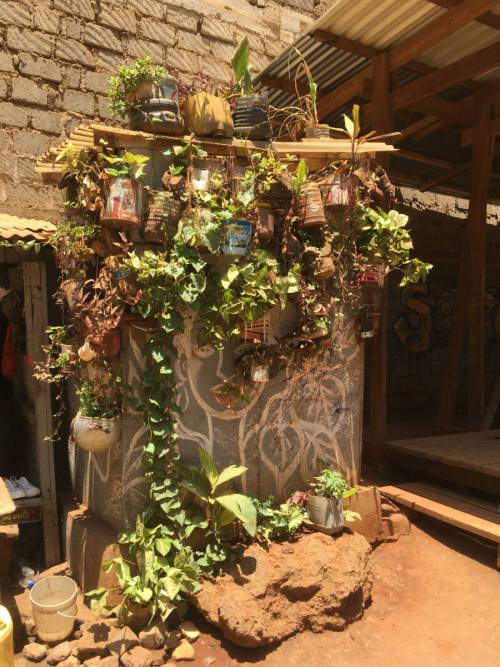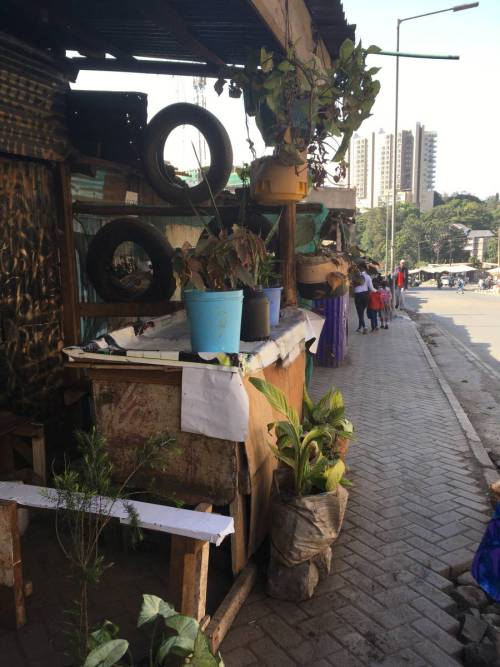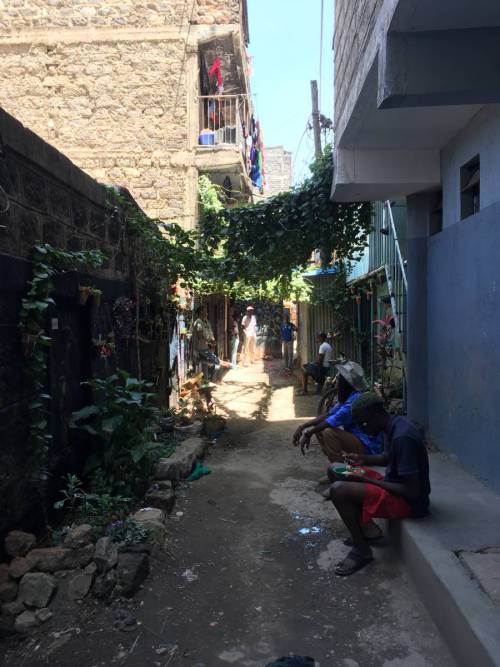Mathare - Future’s Urban Green Oasis
This blog post tells the story of community-led tree-planting activities and youths' efforts in Mlango Kubwa, Mathare, to transform their neighborhood into one that is more conducive to and life-supporting for future generations.
Mathare residential area is in Mathare Valley, Nairobi. Mathare is Kenya's second largest informal settlement, home to 206,564 people, according to the National Census 2019. In reality, the number is three times higher. 70% of Mathare's residents are young people between 15 and 30, and unemployment is remarkably high. Additionally, unemployment, insufficient infrastructure, housing and sanitation, and challenges in the availability of clean water significantly affect the residents' daily lives. Despite the challenges, the young people of Mathare have enormous potential in art, music, sports, and environmental protection.
Fieldwork in Mathare
I conducted a two-month fieldwork period in Nairobi at the beginning of 2024. For my master's thesis, I collected qualitative material through interviews and participant observation in the Mlango Kubwa, one of the 13 villages in the Mathare settlement. During my fieldwork, I had the honor of getting to know, learning from, and spending time with Future Leaders +254 and other young members of the Mlango Kubwa community.
The project was implemented by Future Leaders +254 in collaboration with the Finnish-Kenya Society. Within the framework of the project, Future Leaders +254 and the local community planted 100 plants and trees in ten different locations in the Mlango Kubwa from October to November 2023. The project started with the desire of local youth to "bring butterflies back to Mathare," create enjoyable green spaces, and transform the neighborhood into conducive and life-supporting for future generations. In April 2024, plants were added to new locations, tree nurseries were established, and compost was built. Unfortunately, floods washed away the newly constructed compost along the houses beside the Mathare River a few days later.
I conducted 14 in-depth interviews during the fieldwork period and learned about youths' everyday lives by spending time with them. I aim to understand the social effects of the tree-planting project, how the community's attitudes towards green spaces were shaped during the project, and how the locals perceived the green spaces' role in the community's future. Another goal is to explore the best practices and pitfalls for implementing community-led environmental projects. The findings reflect on the situated knowledge of youths in Mlango Kubwa; the thesis seeks to contribute to the discussion of decolonizing knowledge production and urban theory, which canons, according to Ananya Roy, originates Euro-American urbanism. Decolonizing urban theory is essential for understanding cities in Africa, Asia, and Latin America, termed the "Global South." The cities are often viewed through theories from Europe and North America that overlook cities' diversity and label them "underdeveloped."
In urban planning, recognizing diverse knowledge is critical to creating just cities where residents and social movements, not just institutionalized planning agents, shape their surroundings. Climate change will significantly affect African cities in the future, and local grassroots actors will play an essential role in protecting their environment.
The meaning of the "Big Door" before and in the future
Mathare Valley was formed due to a mine established in the area, which produced building materials for the needs of the colonial administration in the early 20th century. In the 1950s, Mathare was a hideout for the Mau Mau independence fighters who led the insurrection against colonial governance, lasting until independence in 1963. Through Mlango Kubwa ("big door"), weapons were smuggled for the independence fighters who resided in Mathare.
Mathare is vital to Nairobi's history and plays a significant role in its future. Approximately 28% of Kenya's 50 million inhabitants live in cities; of these urban residents, about 60% live in informal settlements. As urbanization accelerates, e.g., due to rural-urban migration and in-situ population growth, affordable neighborhoods like Mathare are at the center, offering housing and a place to live for urban dwellers.
Besides accelerating urbanization and Nairobi County's non-existent urban planning, climate change poses challenges in Mathare. Due to a lack of green spaces, the area can be burning hot during the day, and the floods of the Mathare River endanger the people, animals, and property dwelling near the riverbed.
However, in the context of Mlango Kubwa, due to the absence of urban planning and support from the county, members of Future Leaders +254 and the residents of Mlango Kubwa have taken the initiative to preserve the environment by establishing valuable and meaningful green spaces for humans and butterflies through long-term efforts.
"One major change was getting to know each other"
The interviews and observations show that community-led environmental activities have only brought good things to the local community. Planting events and community clean-ups have served as a medium for social interaction, bringing community members together in a new way and deepening interaction and collaboration in the Mlango Kubwa neighborhood. New connections have also been created with other villages in Mathare, and interest has arisen abroad, bringing foreign visitors to the area.
At first, some community members were doubtful about the environmental activities, but witnessing the young people's persistent care of tree seedlings and flowers convinced the doubters and turned them into supporters. At best, they have participated in the activities, for example, by watering the plants. With the contribution of the entire community, from collecting garbage to watering plants, pleasant green areas have been created in a short time, where even children can play safely. Children actively participate in tree planting and caretaking, taking pride in their plants and encouraging others to help maintain green spaces.
The external appearance of project sites has changed due to flourishing plants and hanging vines. Previously feared areas have been transformed by "soft" green power into cool green oases where young people spend time sharing stories. One recurring theme in the interviews was creating "safe spaces" for young people. In these safe spaces, youths are welcomed as they are, without societal pressures. They also have the opportunity to receive mentoring from older community members.
From the theoretical perspective, observing planting activities through Faranak Miraftab's concept of insurgent planning would be fruitful, as it emphasizes grassroots actions and residents' agency in shaping their environments. Community-led environmental activities seem like insurgent planning, which Miraftab describes as transgressive actions that disrupt the relationship with oppressors and unsettle the status quo through awareness of the past and imagining just and alternative futures. According to Wangui Kimari, residents of Mathare have been perceived as "unwanted subjects and outlaws;" thus, the environmental activities transforming Mlango Kubwa challenge the media image and public narratives of residents and the area.
"An idle mind is the devil's workshop"
Environmental activities have transformed Mlango Kubwa's public spaces and residents' mindsets. Green area maintenance keeps youth away from crime by providing constructive activities. This long-term commitment has also positively shifted older residents' attitudes toward youth. I often heard that "it's almost a crime to be a young man." Community pressure, unemployment, poverty, and a lack of future prospects push young men toward crime, sometimes leading to extrajudicial killings by police.
Extrajudicial killings of young men by the police deepen the community's shared trauma and leave young widowed single mothers to care for children on their own. The stress can diminish single mothers' hope and prospects, leading to depression, substance abuse, and other mental health challenges.
Meaningful activities are needed to keep young people from falling into crime. Future Leaders +254 aims to show that things can be different in Mathare, offering positive alternatives like becoming artists, rappers, poets, actors, dancers, or footballers. Youths have gained environmental protection and gardening skills, which can lead to future employment. Tree nurseries were also described as a potential source of income.
Planting trees and plants has required creativity, as the soil is toxic. Trees have been planted in large barrels, and plants have been placed in used shoes and tumblers. One key aspect of planning green spaces has been putting trees and flowers in visible places. As a result, trees and flowers have aroused interest, particularly among other youths interested in establishing green spaces and gardens in their villages. Therefore, it could be argued that the "soft" green power has been contagious as fast-spreading hanging vines in the Green Hub.
"If you looked at Mathare on satellite, you would only see green"
Interviewees emphasized building a better future for future generations. According to Mirafrab, an essential element of insurgent planning is "imagining just and alternative futures." A local philosophy called "Mathare Futurism" is a crucial principle guiding environmental actions. Mathare Futurism was defined as "imagining possible futures, working towards them, and fixing the current negative cycle." The environmental activities aim to challenge people's perceptions and transform the environment through green spaces. The youths imagined that in the future, children could pick fresh fruits from trees on their way to school, and their idols would be environmental activists and artists instead of thugs. Mathare would be beautiful, green, and life-sustaining, where art would flourish in all its forms.
According to preliminary analysis, "soft" green power is contagious: The seeds of greenness have been sown both in the environment and people's minds. The long-term, persistent, and exemplary work of the Future Leaders +254 members and youths of Mlango Kubwa with plants and trees has inspired other community members to join in - the unity of the neighborhood plays a crucial role in building Mathare's green future.
When you subscribe to the blog, we will send you an e-mail when there are new updates on the site so you wouldn't miss them.





Comments